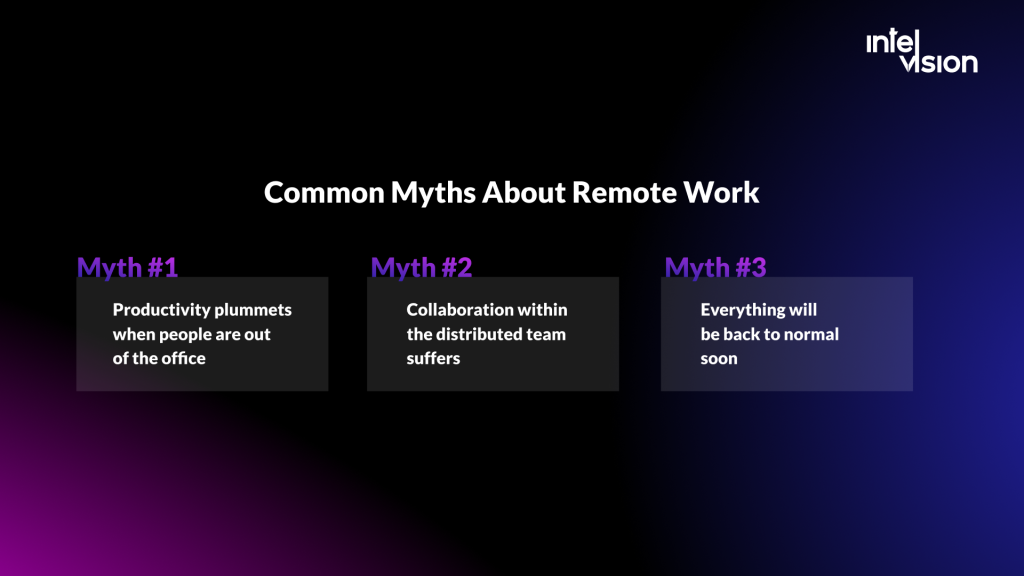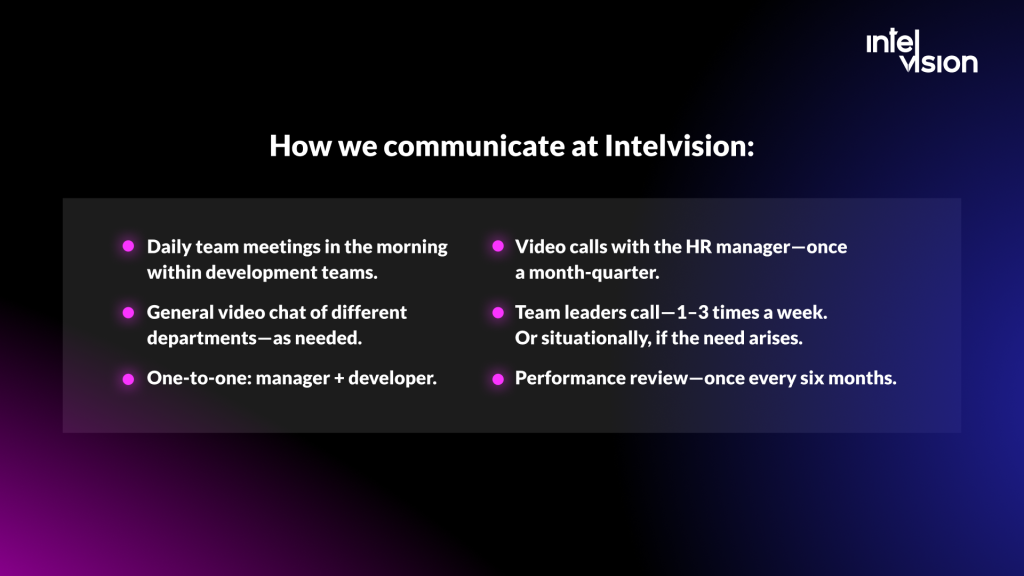
How to Build A Remote Team
Distance is no match for these remote team building activities! Some companies find it hard to accept the new reality: hybrid and completely remote work models are here to stay. According to a study by the consulting company Gartner, 39% of remote workers would rather quit if management insists on a full return to the office.
According to a culture development company Glint, people who have flexible working hours are 2.6 times happier and 3.4 times more successful at balancing work with personal commitments in their company.
However, when you are separated by thousands of miles, bonding and collaborating with colleagues can be a unique challenge. We’ve shared some advice on how to build a remote team with a high level of effective engagement and collaboration in the workplace, no matter where teammates are based.
You might also be interested: Dedicated Development Team: Why Work With Intelvision?
Common Myths and Facts About Remote Work
Forget everything you thought you knew about remote work. We’ve highlighted the most common misconceptions about hybrid and remote work as well as tips on how to build a remote team.
Myth #1. Productivity plummets when people are out of the office
This misconception reflects a longstanding concern that remote workers will sit back down if they are not seen by a manager. According to a study by the American Wharton School of Business, productivity remained stable during the pandemic. In many remote companies, its level even increased.
Much of the increase in productivity became possible since remote team members have gained autonomy and the ability to choose what is best for them. At the same time, a mandatory return to the office can increase team members’ anxiety and reduce productivity, as these measures will limit autonomy.
Myth #2. Collaboration within the distributed team suffers
With regular and transparent communication, flexible work will not affect collaboration within the team. A 2021 survey by consulting firm Gartner found that hybrid remote teams are more:
- flexible: 70% vs 49% for those who work exclusively in the office;
- psychologically safe: 66% vs 47%;
- purposeful: 67% vs 56%;
- empathic: 69% vs 54%.
Myth #3. Everything will be back to normal soon
According to the Gitlab report and current trends, this is not going to happen anytime soon. Of course, leaders may try to force remote employees to return to the office, but there is a risk of losing a significant part of their staff. For most people who have worked remotely, there is no way back into the world without flexible hours.
Twitter CEO Jack Dorsey has announced that employees are allowed to work from home even after the end of the pandemic. The exception will be positions that require a physical presence, for example, maintaining the company’s servers. Twitter’s head of HR Jennifer Christie added that the corporation “will never be the same.”
You might also be interested: How Can an Outsourced Development Team Solve Tech Problems?
How to Build Efficient Remote Teams In 7 Steps
Here are a few tried-and-true best practices to build a remote team and get it engaged.
1. Take Into Account the Specialist’s Experience & Preferences
When choosing an IT project team, be sure to consider:
- the stack the person would like to work with;
- the industry where the specialist would be most interested in working;
- stop lists: topics, projects, and businesses the tech specialist is not ready to work in.
2. Set Clear Goals
According to Officevibe, only 40% of employees are aware of their organization’s strategy and team goals. This is a bad indicator because you are much more likely to keep engaged with an IT team that shares your vision and project goals.
If the development team doesn’t have common goals, there is no team. Then it’s just a group of people who work on product development as long as they benefit from it. The Intelvision team has clear goals. We project them onto everything and voice them everywhere. We also have an internal guideline that describes who we are, and what we strive for.
3. Use Reliable Methods for Communication
How to communicate with remote employees:
- It is important to define communication channels all the workers will use;
- Write down the results, or what was agreed upon, after each meeting.
- Organize a video call with the team once a week. It is important to see a person and to understand how he/she reacts.
- Always ask if you understood the remote worker correctly. This allows you to make sure that what he/she says matches what you understand.
4. Evaluate the Effectiveness of the Work
To motivate developers, use the Performance Review approach, or discussion of the results of the work with specialist managers. Large companies can use the goal-setting method, or OKR (Objectives and Key Results).
However, if a team member hasn’t reached the KPI, do not attribute this to his laziness or inadequacy of the position. Find out the true causes of failure and try to eliminate interference. Perhaps, external circumstances or incorrectly built processes in the company prevented the task from succeeding.
5. Provide Detailed Feedback
The lack of feedback has reactions in the form of conflicts, broken deadlines, and poor quality work. At the same time, proper feedback is a chance to exchange experiences, learn from mistakes and grow professionally.
In addition, research shows that feedback reduces stress, helps build trust in a team, and completes a project at a decent level. Positive feedback can also increase employee productivity by 50% and business results by 20%.
It is important:
- To use the example of specific tasks to show exactly where the employee was wrong.
- To use the sandwich rule. Do not bring down a flurry of claims on the IT specialist. First, praise for the results achieved, and then, point out what needs to be improved.
- Share experiences and cases, give feedback on each project’s stage, coordinate and guide.
6. Invest in Ongoing Training and Development
IT professionals love to learn. According to the American platform Peakon, among the top reasons for layoffs are stagnation and the lure of a “new opportunity” and the lack of offline and remote onboarding. This is confirmed by 32 million survey participants from 125 countries. And according to LinkedIn, 94% of new employees wouldn’t quit their last job if management invested in their development.
Help your remote team members to grow with specialized conferences, seminars, workshops, and digital tools. Do not forget about Junior specialists: pay for online courses for those who need to be upgraded. Encourage them to participate in remote workshops and professional conferences, even during work hours.
For example, Intelvision gives its remote workers all the possibilities to grow, endorse their expertise, and pass various certifications. All the employees, from a software engineer to a project manager, get a chance to boost their knowledge and programming skills.
7. Implement Team-Building Events
Remote team building activities are worthwhile for team bonding. They help to rally the team and strengthen the remote employees. They are effective for several reasons:
- They increase the level of employee motivation—as a result, this ultimately brings the company 2.5 times more profit than businesses with a low indicator.
- Creative challenge-solving corporate events often help improve negotiation and problem-solving skills.
Involve departments that don’t usually work together for remote team building. According to the American Psychological Association, activities that span across departments are more likely to improve performance.
Remote Corporate Culture: How It Works at Intelvision
We at Intelvision are supporting a work-from-home culture—and that was the case even before the pandemic. We are distinguished by trust in employees, transparent communication, proactivity, and time management.
While building a successful remote team and working from home, it’s more important than ever to talk about what’s going on. Moreover, both downward and upward communication is important. We communicate every day in our departments. We teach employees that it is necessary not only to receive information, but also to share it, telling if everything is in order with the task, how is the progress, and if there are any difficulties.
Managers make it clear to employees that they trust their professionalism, responsibility, and ability to make the right decisions. This trust breeds responsibility on their part. When an employee feels that he is trusted, he is ready to confirm this trust with the quality of work. And in return, he receives even more trust.
How we communicate at Intelvision:
- Daily team meetings in the morning within development teams.
- General video chat of different departments—as needed.
- One-to-one: manager + developer.
- Video calls with the HR manager—once a month-quarter.
- Team leaders call—1–3 times a week. Or situationally, if the need arises.
- Performance review—once every six months.
In the US, there is a practice—small talk before any conversation. Whatever call you get—internal or external, with a colleague or a client—you will stumble upon small talk. This is an informal conversation on general topics. Its goal is to tune in to each other, to catch the same wave.
The transition from small talk to the issue you are about to discuss is often abrupt—”Okay, now let’s move on to our topic.” And that’s okay. People understand what they are going to talk about, and small talk defuses the situation a little. We at Intelvision use this approach to communicate with the team. When working remotely, informal communication is a gold mine. After talking about tasks, managers ask colleagues how they are doing in general.
Remote work is about performing specific tasks. Therefore, we do not focus on the process, focus on the result and give our people more freedom. Control is demotivating: people give up when they need to report for every minute spent in front of the computer. Let employees plan their work day. The main thing is that all colleagues know who is in touch and when exactly. To do this, we’ve set expectations, as well as prescribed a work schedule and rules for remote work. Also, take into account the difference in time zones. This allows employees to adapt faster, and our company to prevent chaos.
Learn more about our experience at Intelvision, pros and cons of working remotely, and more via link.
Conclusion
These ideas for building a remote team will help get the leadership to the next level and spread your ideals. When your remote workforce is driven by your values and mission, they will have a clear purpose and expectations to motivate them. So do not be surprised if you notice higher employee engagement, productivity, and loyalty as a result.












![$portfolio_img_mobile['title'] $portfolio_img_mobile['alt']](https://intelvision.pro/wp-content/uploads/2022/11/Visoplan.-Mobile-banner-263x350.png)









